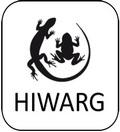About us
About Us
Hampshire is fortunate that the county covers a huge geographic area and a very diverse breadth of habitat including: the Isle of Wight, the New Forest National Park, the South Downs National Park, as well as many other unspoiled areas, including Woolmer Forest.
It is therefore unsurprising that we are host to 12 out of the 13 native amphibians and reptiles in UK, including rarities such as the Natterjack Toad, Sand Lizard and Smooth Snake, and wherever you live in the county there will be opportunities to survey and monitor an assemblage of amphibian and reptile species.
HIWARG formed in the Autumn of 2018 and is an affiliated independent ARG-UK group. The group focus is conservation of native UK species essentially around habitat management, surveying, public engagement, volunteer training & doing as much as possible to understand & protect the native species in the county.
All members are volunteers with a common interest.
If you have some spare time and would like to be involved with HIWARG, maybe you have taken a photo of a reptile or amphibian and would like it identified or maybe you have some other query, then please do get in contact info@hiwarg.org.uk
CONSERVATION THROUGH EMPATHY BY ENGAGEMENT
We now have a new website. Please visit https://hiwarg.org/
Visit HIWARG's Redbubble Shop to support our work www.redbubble.com/people/HIWARG/shop
News
News
Big Green Frog Hunt 2024
We are interested in the locations and distribution of the non-native Pelophylax water frog species wherever they are found in Hampshire and the IoW, but are especially keen to know if you have seen or heard them in the following locations:
Aldershot, Farnborough, Fleet and Odiham, (especially on the Basingstoke Canal)
Alton, Bentley, Alice Holt and Rowledge areas, especially along the River Way catchment.
Alresford area, mostly from the roads and footpaths around the ponds and watercress bed.
The Pig Bush, Kings Hat and Ipley inclosure areas of the New Forest.
If you are out and about in the above areas over the next few weeks, listen out for some unusual, and loud, frog calls... watch the video for an example.
There are four species of water/green frogs (Pelophylax species) in Hampshire and all have a roughly similar call. We have used the edible frog call as an example in the linked video as that is roughly somewhere in the middle of the range.
As a general rule of thumb, if you can see the calling males and they have pale/white vocal sacs on either side of their jaw when inflated, they will most likely be one of the pool frog species, if they have dark grey vocal sacs and are very large frogs they will most likely be marsh frogs and pale/mid grey vocal sacs most likely to be edible frogs.
As always, log your sightings on www.recordpool.org.uk and share any photos or videos on this group if you can. Thanks ![]()
Calling edible frogs: https://www.youtube.com/watch?v=-mtaXVXaw1w
If you are on Facebook you will find more details here: https://www.facebook.com/groups/455730808110700/permalink/2170339753316455/
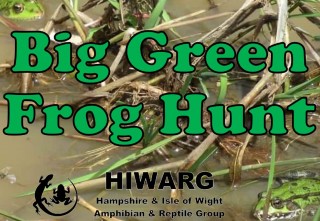
Midwife Toads in the Winchester (Littleton, Weeke and Teg Down areas in particular) and possibly Colden Common areas
Despite the lack of records, there is an anecdotal comment to suggest that Midwife Toads were known from the Winchester area and so we are reaching out to residents for their help in finding these elusive toads. By far the best way to identify the presence of Midwife Toads is by their calls, which has been likened to “an electronic beep, like a smoke alarm with a dying battery or a New Age car alarm” by Steve Allain, one of the lead national researchers of Midwife Toads.
With tonights drizzling rain, it is more likely that they will start calling if thay are still around. Visit the following links to hear a sample of Midwife Toads calling
http://stevenallain.co.uk/.../scifri-whats-that-beeping...
www.youtube.com/watch?v=SVPK899UwV8
Midwife Toads are smaller than our native toads, with adults reaching around 5cm in length. They can also be distinguished by their eyes, if you are lucky enough to spot one, which have vertical pupils as opposed to horizontal/oval pupils of our two native toads. A big difference with these toads is that they are not as reliant on ponds for breeding, as the male toads carry the eggs wrapped around their back legs, hence their name. Breeding usually takes place between April and June so they should have been calling for a few weeks now, but the dry weather may have affected this..
We are hoping that residents in the Winchester area (especially Littleton, Weeke and Teg Down) will be willing to help by listening out on warm damp nights for the “beeping” toads. If you do hear these calls it would be really helpful if you can record the calls on your phone, or take photos if you manage to see one.
For all sightings/recordings, please contact us on:
HIWARG Amphibian Officer: amphibians@hiwarg.org.uk or HIWARG on Facebook www.facebook.com/groups/455730808110700
Steve Allain: www.facebook.com/SJRAllain or https://twitter.com/stevoallain
Midwife Toads in Hampshire 2023
Midwife Toads are not a native species to the UK, but have been found in several colonies in parts of the country. Hampshire has been named as one of these locations in several sources, but there are no actual records that we are aware of. Despite the lack of records, there is an anecdotal comment to suggest that Midwife Toads were known from the Littleton area and so we are reaching out to residents for their help in recording these elusive toads.
Midwife Toads are smaller than our native toads, with adults reaching around 5cm in length. They can also be distinguished by their eyes, if you are lucky enough to spot one, which have vertical pupils as opposed to horizontal/oval pupils of our two native toads. By far the best way to identify the presence of Midwife Toads is by their calls, which has been likened to “an electronic beep, like a smoke alarm with a dying battery or a New Age car alarm” by Steve Allain, one of the lead national researchers of Midwife Toads. A big difference with these toads is that they are not as reliant on ponds for breeding, as the male toads carry the eggs wrapped around their back legs, hence their name. Breeding usually takes place between April and June so they should have been calling for a few weeks now. Visit Steve’s blog to hear a sample of Midwife Toads calling http://stevenallain.co.uk/.../scifri-whats-that-beeping... you can also hear individual calls on this Youtube link www.youtube.com/watch?v=SVPK899UwV8
We are hoping that residents in the Winchester area (especially Littleton, Weeke and Teg Down) will be willing to help both Steve Allain and HIWARG, by listening out on warm damp nights for the “beeping” toads. If you do hear these calls it would be really helpful if you can record the calls on your phone, or take photos if you manage to see one.
For all sightings/recordings, please contact us on:
HIWARG Amphibian Officer: amphibians@hiwarg.org.uk or HIWARG on Facebook www.facebook.com/groups/455730808110700
Steve Allain: www.facebook.com/SJRAllain or https://twitter.com/stevoallain
Stuck for something to do over the Easter Weekend?
Big Green Frog Hunts are more exciting, than Easter egg hunts (although maybe not as tasty).
Conditions are not the best, but with sunny spells and temperatures tickling the 'teens over the weekend, the chances of spotting water frogs are on the increase. Pack a picnic, check the area on the map below and go for a walk. Take a camera and record your sightings and photos on www.recordpool.org.uk
Water frogs are non-native frogs in the Pelophylax group. They are a tricky group to ID to species accurately in the field so we typically call them water frogs.
As they are a complex of species, adult size can range from a similar build to our common frogs up to 50% larger. Other ID features are:
- A very rounded nose/jaw, almost conical;
- Eyes are more prominant and closer together than on common frogs;
- They lack the "bandit" eye patch behind the eyes, as with common frogs;
- Can have a yellow/green line down their spine, but not always present/obvious;
- Lateral ridges on either side of their back;
- Almost always in or close to water, often basking in the sun;
- Will almost always spot you first, jumping into the water and disappearing immediately;
- Calling males will have two vocals sacs, either side of their jaw. (common frogs call with their throat.)
- Male calls sound like a cackling, croaking, quacking sound... they can sometimes be called laughing frogs.
We have four water frogs in our area, Marsh frog, Edible frog, Southern clade pool frog and Perez's frog. The following video will give you a rough idea of what to look for and hopefully listen out for: www.youtube.com/watch?v=472zFshwasA
You can download a fab ID guide at www.arguk.org/info-advice/id-guides/441-amphibian-id-guide-revised-2019-pdf

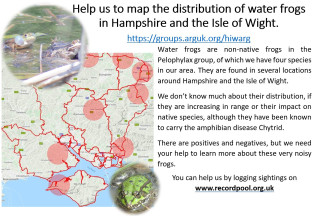
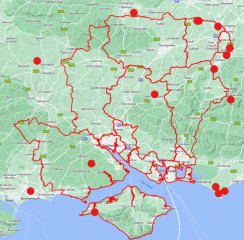
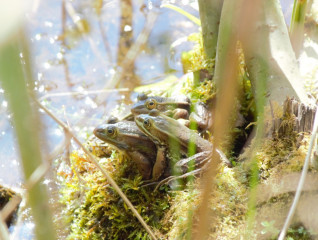
Toads need your help
Toads and other amphibians have started migrating to their breeding ponds, but often get killed on our roads. There are three registered toad crossings on Froglife's Toads on Roads Map, but only two are manned by patrollers. If you can help save toads and other amphibians by becoming a Toad Patroller, visit https://www.froglife.org/what-we-do/toads-on-roads/tormap/ and find your nearest crossing.
If you want to know what Toad Patrols do, you can read more here https://www.froglife.org/wp-content/uploads/2023/01/Patrol-Pack-2023-compressed_compressed.pdf
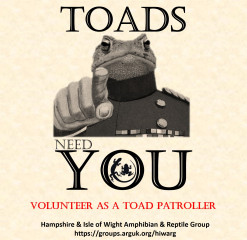
Events
Events
Past Events
Show Upcoming EventsSpawn Spotters & Toad Patrols: Amphibian activities for all
Tue 12th January, 2021 - Tue 12th January, 2021
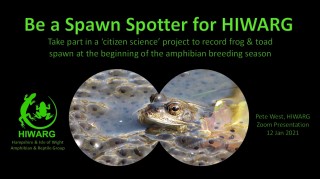
To start 2021 off with a positive tone, Pete West of HIWARG is presenting two amphibian topics that are suitable for both members and non-members alike, but with an emphasis on those with less experience.
“Spawn Spotters” is a citizen science project to encourage people to record amphibians seen in their gardens, or on their favourite walks. It focuses largely on frogspawn, as this is an easy indicator of frog population size and also helps to record the dates of the first sightings of the year and peak spawning times. The talk will provide basic friendly advice on how to record these sightings in a meaningful way and how to access help to identify what you have found. It also briefly looks at other opportunities if you are keen to get involved further.
“Toad Patrols” explains how and why groups of volunteers ‘patrol’ toad crossings across busy roads to save toads and other amphibians. This is a great way for people to get involved in a hands on conservation activity for a short length of time, but have a huge impact on the local populations of amphibians. It is also an opportunity to get really close up to amphibians and learn about their ecology and life cycle.
Come and join us on the 12th Jan with no obligation to get involved, but we hope you will become as passionate about amphibian conservation as the rest of us.
The Zoom meeting link will be shared via email before the event starts.
REGISTER FOR FREE HERE: Eventbrite/HIWARG
THE ZOOM LINK WILL ONLY BE SENT TO EVENTBRITE REGISTERED ATTENDEES.
Heath Week 2021 - Forest Finds at Bramshill
Thu 29th July, 2021 - Thu 29th July, 2021
Next Thursday, 29 July, we have been invited to join Natural England and Forestry England on their Heath week activity at Bramshill SSSI
We will have a stall there to talk to visitors about herps in the area and it will be a great chance to engage with walkers and other users of the site.
If anyone is free to help us set up our gazebo between 8am-8.30am that would be great. The event is advertised as 9am to 3pm, so if anyone is free and would like to help on the stall, or just stop by and chat it would be good to see you.
Meeting place is at Bramshill Common Wood Car Park, Bramshill Rd, Hook RG27 0PR (Grid ref SU 76053 61310). It is only a small car park, so if its full there is more parking about 500m east along Bramshill Road. The stall will be sited next to the car park.
Both Natural England and Forestry England will be running their own activities, with FE leading guided walks.
https://www.tbhpartnership.org.uk/event/forestry-finds/
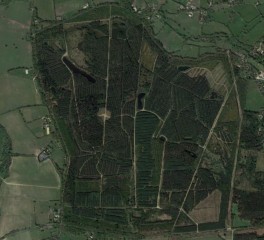
Habitat Management at St John's Churchyard New Alresford
Sat 20th November, 2021 - Sat 20th November, 2021

Habitat Management at St John's Churchyard New Alresford. SO24 9AG
20 Nov 2021
10am - 1pm
Please bring loppers, bow saw, gardening gloves for the brambles, snack, drink, waterproof clothing.
Cheap Pay and Display parking at Station Road Car Park SO24 9JL
Crassula Bashula III: Revenge of the Pith
Sun 21st November, 2021
The Crassula is back (Boo, hiss), but our attempts have had some impact, particularly where we have followed up with spot checks.
This is going to be a long and arduous trek to control this plant, but we will will beat it back a much as we can.
The Crassula has also invited its Bur-reed pals to the party, so we aim to start taking out some of this as well. As said before, this is an ongoing event, so episode IV will be planned towards the end on Nov, start of Dec.
Bring buckets/garden trugs, shovels, hand trowels/forks, work gloves (preferably waterproof), wellies a drink and something to eat.
Meet at the village green and park along Tylney Lane towards the Old House at Home pub.
PLEASE ENSURE THAT YOU DISINFECT YOUR FOOTWEAR/WELLIES BOTH BEFORE AND AFTER THE EVENT. See Advice note 4 below.
Advice Note 4: Amphibian Disease Precautions: A Guide for UK Fieldworkers
Habitat Management 2, Drove End Ringwood Forest
Sat 27th November, 2021
A joint event with DARN. Clearing birch and pine from heather with hand tools. Please bring drink, snack, gloves, loppers and bow saw - some tools will be available. We look forward to seeing you there!
Meet at 10am at Drove End Forestry England Car Park, Harbridge Drove, BH24 3PX, near Alderholt. Event finishes at 1pm
Yateley Common Sunday Conservation Volunteers
Sun 28th November, 2021 - Sun 28th November, 2021
Join the Sunday Conservation Volunteers to help carry out winter scrub cutting on Yateley Common and help to conserve and maintain the open Heathland habitat. The group meet 10-1 on the last Sunday of every month. Locations vary so please contact northern.sites@hants.gov.uk for more information
Zoom Meeting: Amphibian season 2022 overview - 05/01/22 @ 7pm
Wed 5th January, 2022
We hope everyone has had a good Christmas.
We are starting to prepare for 2022 and thought we would open up our Amphibian "Dip in" sessions to everyone to give an update on our plans for the next few months.
Join us for details on:
Toad patrols
Spawn spotting
Surveys
Training (for beginners and intermediates)
Resources
Topic: HIWARG Amphibian Dip In
Time: Jan 5, 2022 07:00 PM London
Join Zoom Meeting
https://us02web.zoom.us/j/83963781221?pwd=RDBlS2dkOWpLWi81KzAwZnU3TXpsZz09
Meeting ID: 839 6378 1221
Passcode: 399728
Crassula Bashula: HIWARG Strikes Back
Sat 23rd July, 2022
9am to 12.30pm
Tylney Lane, Newnham, Hook RG27 9AJ
Event details:https://fb.me/e/5yEh4mF8T
This hot weather may be shortening the amphibian survey season somewhat, but it is giving us an early stab at beating back the invasive non-native Crassula helmsii at this important pond with five species of amphibians.
No experience necessary as I will give a full briefing before we start. The more volunteers we have on the day, the bigger effect we will have.
I have made this event slightly earlier than usual for work event so we hopefully get the coolest part of the day. We will be working slowly and methodically as accuracy and attention to detail is much more important than a hack and slash approach.
I will provide refreshments and a gazebo to get us through the session, but feel free to bring your own. We are right next to a village pub so can 'debrief' there afterwards if anyone fancies that ![]()
Bring:
water/drinks to keep yourself hydrated
Suncream
sun hat
comfortable, but sensible footwear for a practical activity (trainers are OK, but no open toe/back footwear)
some kneeling may be involved, so kneepads/mats will be useful
shovels/spade, rakes*
work gloves (waterproof)*
buckets/garden trugs etc for moving small loads of waste*
snacks/something to eat
*Please make sure that your footwear and tools have been cleaned and disinfected before and after the event as per biosecurity guidelines:
1. Use brush to scrub off any debris, plant fragments, mud
etc.
2. Rinse with water (pond water will suffice).
3. Soak in 4% bleach solution for at least 5 minutes, or Virkon for at least one minute (5 minutes where Bsal is
suspected).
4. Rinse with clean water.
5. If possible, allow to dry for before next use.
6. Keep field equipment inside plastic bags during transit and storage (after thorough drying) to reduce the
chance of transmitting pathogens.
https://www.arguk.org/.../324-advice-note-4.../file
Meet at the village green and park along Tylney Lane towards the Old House at Home pub. If we get a few people attending, I will direct parking as appropriate.
Hurn Forest Habitat Management 2
Sat 22nd October, 2022 - Sat 22nd October, 2022
A joint event with DARN. Clearing Birch and Pine from heather with hand tools. Please bring drink, snack, gardening gloves, waterproofs. Also bring loppers and bow saw if you have them - some tools will be available. We look forward to seeing you there!
Hurn Forest, Boundary Lane Forestry England Car Park (free) BH24 2SE off A31/St Leonards 10am to 1pm
Crassula Bashula: Abbotswood Round 2
Sat 22nd October, 2022 - Sat 22nd October, 2022
No experience necessary as I will give a full briefing before we start. The more volunteers we have on the day, the bigger effect we will have.
We will be working slowly and methodically as accuracy and attention to detail is much more important than a hack and slash approach.
Bring:
> Appropriate clothing for the day: waterproofs, sunhat if we are lucky
> comfortable, but sensible footwear for a practical activity: boots, wellies
> some kneeling may be involved, so kneepads/mats will be useful
> shovels/spade, hand trowels, rakes*
> work gloves (waterproof)*
> buckets/garden trugs etc for moving small loads of waste*
> snacks/something to eat
> water/drinks to keep yourself hydrated
*Please make sure that your footwear and tools have been cleaned and disinfected before and after the event as per biosecurity guidelines:
1. Use brush to scrub off any debris, plant fragments, mud
etc.
2. Rinse with water (pond water will suffice).
3. Soak in 4% bleach solution for at least 5 minutes, or Virkon for at least one minute (5 minutes where Bsal is
suspected).
4. Rinse with clean water.
5. If possible, allow to dry for before next use.
6. Keep field equipment inside plastic bags during transit and storage (after thorough drying) to reduce the
chance of transmitting pathogens.
For more details read Advice Note 4: https://www.arguk.org/.../324-advice-note-4.../file
Parking is difficult as there are no spaces or options next to the site, so provisionally we will be meeting at the Co-op car park, Abbotswood Common Road, Abbotswood, Romsey SO51 0BX 10am to 1pm
Join up or Log In
Join up or Log In
Members sign in here

OR
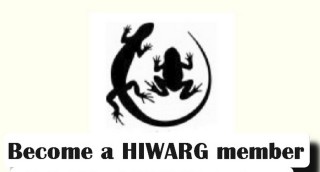
Membership costs just £6.00 per year as a subscription that can be cancelled at any time.
Your membership will help HIWARG to protect the amphibians & reptile of Hampshire.
Be aware of and take part in conservation opportunities, surveys and many other activities across the county.
Click here to go directly to PayPal to subscribe as a member:
Donate to HIWARG
Donate to HIWARG
Info & ID guides
Info & ID guides
Identification Guides
Amphibian Identification - downloadable colour cards : a great ID guide from ARG UK/ARC
Newt Eggs & Larvae - downloadable colour cards : an excerpt from the above guide, specifically on newt eggs and larvae
Its a small newt but which one : a HIWARG guide to help differentiate smooth newts and palmate newts
Reptile Identification - downloadable colour cards : a great ID guide from ARG UK/ARC
Non-Native Species ID Sheets (NNSS Website) : ID sheets from the Non Native Species Secretariat
Alien Amphibian and Reptile Species in the UK : A bilingual guide (English/Welsh) from ARC
Projects & Citizen Science
#BigGreenFrogHunt: Southern Clade Pool Frogs calling A YouTube video of southern clade pool frogs calling in North Hampshire
#BigGreenFrogHunt: Marsh frogs calling
DARN's 'Slow Worms in Churchyards' project
'Amphibians & Reptiles on Allotments' Introduction Leaflet
"Spawn Spotters" presentation 12 Jan 2021
Toad Patrol presentation 12 Jan 2021
Gotta love a larva presentation 9 July 2021
HIWARG Video: Spawn Spotters and Toad Patrols Jan 2021
HIWARG Video: Amphibian surveys: ID'S & Survey Methods March 2021
Habitat Management and Creation
![]() Reptile Habitat Management Handbook
Reptile Habitat Management Handbook
![]() Amphibian Habitat Management Handbook
Amphibian Habitat Management Handbook
Creating Garden Ponds - downloadable booklet
Creating Ponds for Amphibians and Reptiles (Freshwater Habitats Trust)
Guide to the Restoration, Creation and Management of Ponds (Freshwater Habitats Trust)
Habitat Management guides (Buglife) - Not specifically herp based but a great set of guides
How to Create Invertebrate and Reptile Mounds (Magnificent Meadows)
Creating Grass Snake Egg-laying Heaps (ARG UK and RAVON)
Advice and Information
ARC's "Dogs and Adders" Advice Sheet
"There is a Snake in my Garden - What can I do?" (ARG UK)
Policies/Health & Safety
HIWARG Safeguarding Policy and Protocols June 2020
Buddy System/Lone Working Procedures
ARG UK Generic Risk Assessment July2020
Herp Diseases - Recognise & Report
REPORT SICK OR DEAD WILDLIFE TO GARDEN WILDLIFE HEALTH
Advice Note-4: Amphibian disease precautions - a guide for UK fieldworkers
Reptile Slough Genebank - collection & submission of found sloughs
Garden Wildlife Health - Severe Perkinsea Infection (SPI)
Other
Fixing Enkamat to Gully Pots - Initial Findings in Sussex
Useful glossary of terms often used within the herpetological field. (Credit due - unknown)
Kids stuff - Educational items for the young ones
Pond pack Animal fact sheets Animal colouring sheets
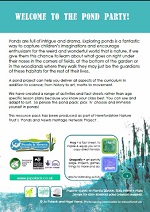
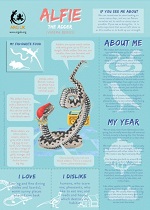
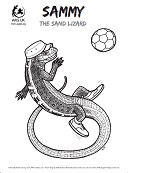
Photo gallery
Photo Gallery
Contact us
Contact Us
If you would like more information about HIWARG or have something to share with us, please get in touch via the link to our social media presence.
Upcoming Events
Upcoming events will be listed here.
Latest News
- Big Green Frog Hunt 2024
21/05/2024 6:16 pm - Midwife Toads in the Winchester (Littleton, Weeke and Teg Down areas in particular) and possibly Colden Common areas
18/06/2023 8:11 pm - Midwife Toads in Hampshire 2023
19/04/2023 11:05 pm - Stuck for something to do over the Easter Weekend?
05/04/2023 11:20 pm - Toads need your help
21/02/2023 12:23 am
© Hampshire And Isle of Wight Amphibian and Reptile Group (HIWARG)
Website hits: 58110
View All | Find out how to get a mini-website for your ARG
© ARG UK Local Groups mini-websites 2025
Wind powered websites by Aye-aye Design.
